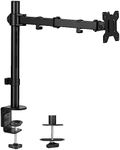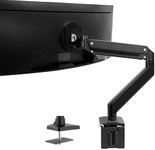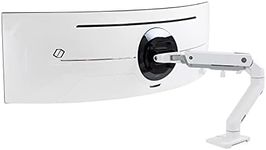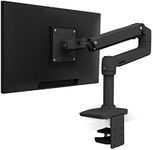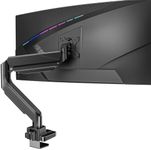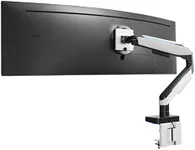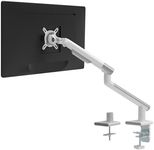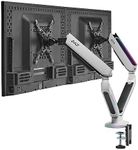Buying Guide for the Best Ultrawide Monitor Mount
Choosing the right ultrawide monitor mount can make a big difference in your workspace comfort and productivity. Ultrawide monitors are larger and heavier than standard monitors, so it's important to find a mount that can safely support your screen while offering the flexibility and adjustability you need. Before you start shopping, think about how you use your monitor, how much desk space you have, and what kind of adjustments you want to make throughout the day. A good mount will help you position your monitor at the perfect height and angle, reducing strain on your neck and eyes.Weight CapacityWeight capacity refers to the maximum weight the mount can safely hold. This is crucial because ultrawide monitors are often heavier than regular monitors. If the mount can't support your monitor's weight, it could sag, become unstable, or even break. Mounts are usually divided into light-duty, medium-duty, and heavy-duty categories. Light-duty mounts are for smaller, lighter monitors, while heavy-duty mounts are designed for the largest and heaviest ultrawide screens. To pick the right one, check your monitor's weight (including the stand if you plan to use it) and choose a mount that can handle a bit more than that for safety.
VESA CompatibilityVESA compatibility refers to the pattern of holes on the back of your monitor that the mount attaches to. The VESA standard is measured in millimeters, such as 100x100 or 200x100. This is important because your mount and monitor need to have matching VESA patterns to fit together. VESA patterns for ultrawide monitors can vary, so always check your monitor's specifications. If your monitor has a non-standard pattern, you may need an adapter. Make sure the mount you choose supports your monitor's VESA size to ensure a secure fit.
Mounting TypeMounting type describes how the mount attaches to your desk or wall. The most common types are desk clamp, grommet, and wall mount. Desk clamps attach to the edge of your desk, grommet mounts go through a hole in your desk, and wall mounts attach directly to the wall. Desk clamps are easy to install and move, while grommet mounts are more stable but require a hole in your desk. Wall mounts save desk space but need wall installation. Choose the type that fits your workspace and installation preferences.
AdjustabilityAdjustability refers to how much you can move your monitor once it's mounted. This includes height adjustment, tilt, swivel, and rotation. Some mounts offer full motion, letting you move the monitor up, down, side to side, and even rotate it. Others are more basic and only allow for limited adjustments. If you like to change your monitor's position often or share your screen with others, look for a mount with more adjustability. If you usually keep your monitor in one position, a simpler mount may be enough.
Arm Length and ReachArm length and reach describe how far the mount can extend your monitor from its attachment point. This is important for ultrawide monitors because you may need extra reach to position the screen comfortably, especially if you have a deep desk. Mounts with longer arms can bring the monitor closer or push it further away as needed. If you want to pull your monitor forward or push it back frequently, look for a mount with a longer reach. If your desk is shallow or you keep your monitor close, a shorter arm may be fine.
Cable ManagementCable management refers to features that help organize and hide your monitor's cables along the mount's arm. This keeps your workspace tidy and prevents cables from getting tangled or damaged. Some mounts have built-in channels or clips for cables, while others do not. If you value a clean and organized desk, look for a mount with good cable management features.
